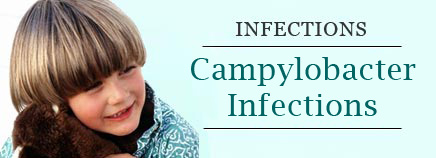
Campylobacter bacteria, usually transmitted in contaminated food or water, can infect the gastrointestinal tract and cause diarrhea, fever, and cramps. Good hand-washing and food safety habits will help prevent Campylobacter infections (or campylobacteriosis), which usually clear up on their own but sometimes are treated with antibiotics.
Campylobacter infects over 2 million people each year, and it’s a leading cause of diarrhea and foodborne illness. Babies younger than 1 year old, teens, and young adults are most commonly affected.
Causes
Campylobacter is found in the intestines of many wild and domestic animals. The bacteria are passed in their feces (poop), which can lead to infection in humans via contaminated food, meats (especially chicken), water taken from contaminated sources (streams or rivers near where animals graze), and milk products that haven’t been pasteurized.
Bacteria can spread from person to person when someone comes into contact with fecal matter from an infected person (especially a child in diapers). Household pets can carry and transmit the bacteria to their owners.
Once inside the human digestive system, Campylobacter infects and attacks the lining of both the small and large intestines. The bacteria also can affect other parts of the body. In some cases — particularly in very young kids and those with chronic illnesses or a weak immune system — the bacteria can get into the bloodstream (called bacteremia).
In rare cases, campylobacteriosis can lead to Guillain-Barré syndrome, a rare autoimmune disorder.
Symptoms
Symptoms usually appear 1 to 7 days after ingestion of the bacteria. The main symptoms of Campylobacter infection are fever, abdominal cramps, and mild to severe diarrhea. Diarrhea can lead to dehydration, which should be closely monitored. Signs of dehydration include thirst, irritability, restlessness, lethargy, sunken eyes, dry mouth and tongue, dry skin, fewer trips to the bathroom to urinate (pee), and (in infants) a dry diaper for several hours.
In cases of campylobacteriosis, the diarrhea is initially watery, but later may contain blood and mucus. Sometimes, the abdominal pain seems to be a more serious symptom than the diarrhea. When this happens, the infection may be mistaken for appendicitis or a problem with the pancreas.
Prevention
You can prevent Campylobacter infection by using drinking water that’s been tested and approved for purity, especially in developing countries, and by drinking milk that’s been pasteurized. While hiking and camping, don’t drink water from streams or from sources that pass through land where animals graze.
Kill any bacteria in meats by cooking them thoroughly and eating while still warm. Whenever you prepare foods, wash your hands well before and after touching raw meats, especially poultry. Wash cutting boards, countertops, and utensils with soap and hot water after contact with raw meat.
As you care for a family member who has diarrhea, remember to wash your hands before touching other people in your household and before handling foods. Clean and disinfect toilets after they’re used by the person with diarrhea. Also, if a pet dog or cat has diarrhea, wash your hands often and check with your veterinarian about treatment.
Diagnosis
Your doctor may send a stool sample to the lab to be tested for Campylobacter bacteria. Other lab tests also might be needed, especially if your child has blood in the stool. If your doctor suspects an infection in the bloodstream (bacteremia), a blood culture might be ordered.
Treatment
Most kids with Campylobacter infection will recover without medication. Sometimes, a doctor may prescribe an antibiotic, especially if the child is very young or the symptoms are severe or lasting. If your child receives an antibiotic, give it on schedule for as long as the doctor has ordered. Also, do not give nonprescription medicines for diarrhea without first checking with your doctor.
After seeing a doctor, most kids with Campylobacter infections are treated at home, especially if they show no signs of being seriously dehydrated. They should drink plenty of fluids as long as the diarrhea lasts and be watched for signs of dehydration.
Kids with mild diarrhea and no dehydration should continue to eat normally and increase their fluid intake — but fruit juices and soft drinks can worsen diarrhea and should be avoided. If your child is dehydrated, your doctor may recommend using an oral rehydration solution. Babies with campylobacteriosis who are breastfed should continue to be breastfed throughout the illness.
Diarrhea usually stops within 2 to 5 days. Full recovery usually takes about 1 week. In about 20% of cases, diarrhea can last longer or stop and then come back.
When to Call the Doctor
Call your doctor if your child:
- has diarrhea streaked with blood
- is vomiting
- shows any signs of dehydration
- has abdominal pain
- has a high fever
With some rest, most kids with Campylobacter infection can quickly make a full recovery.

